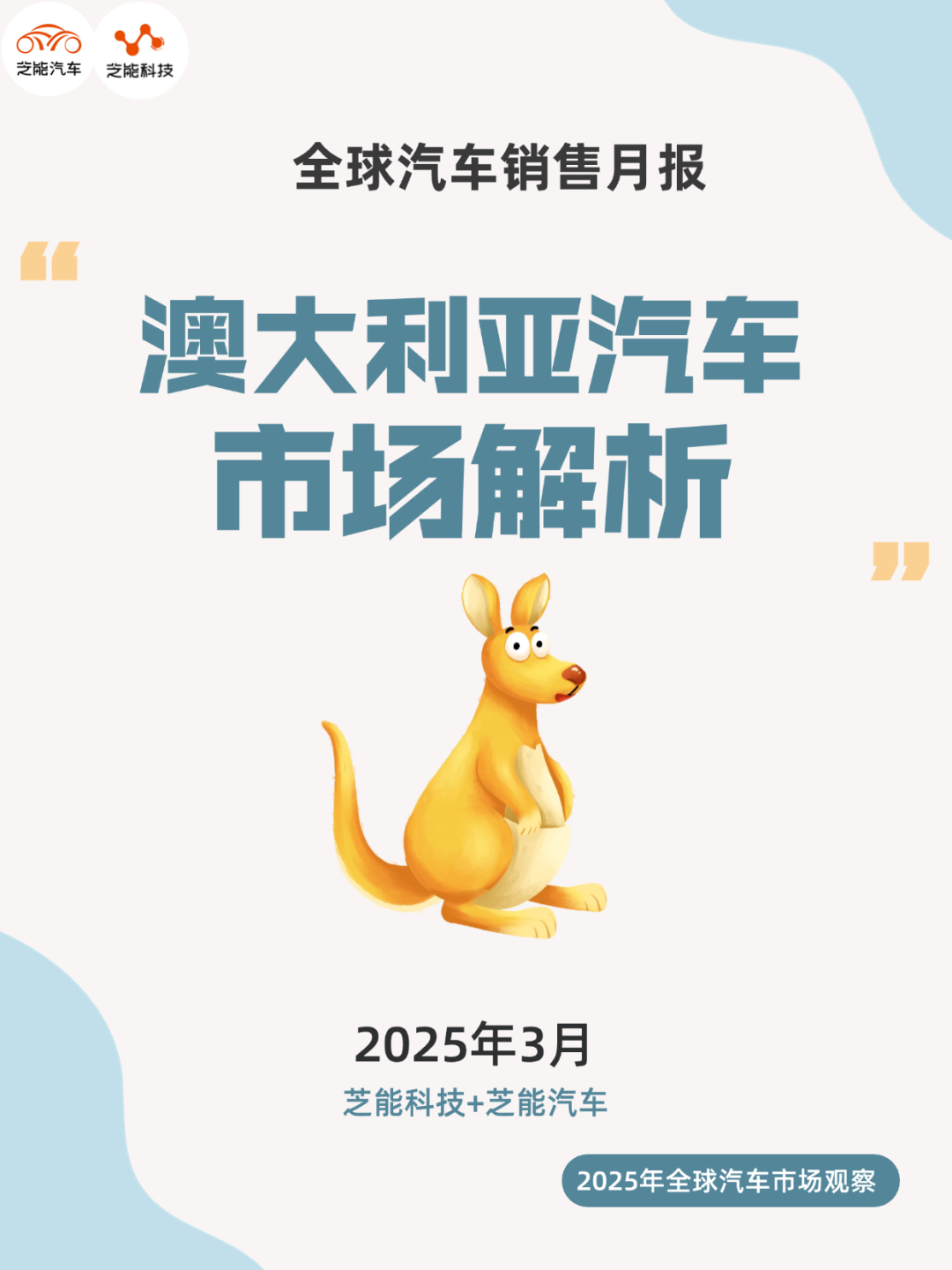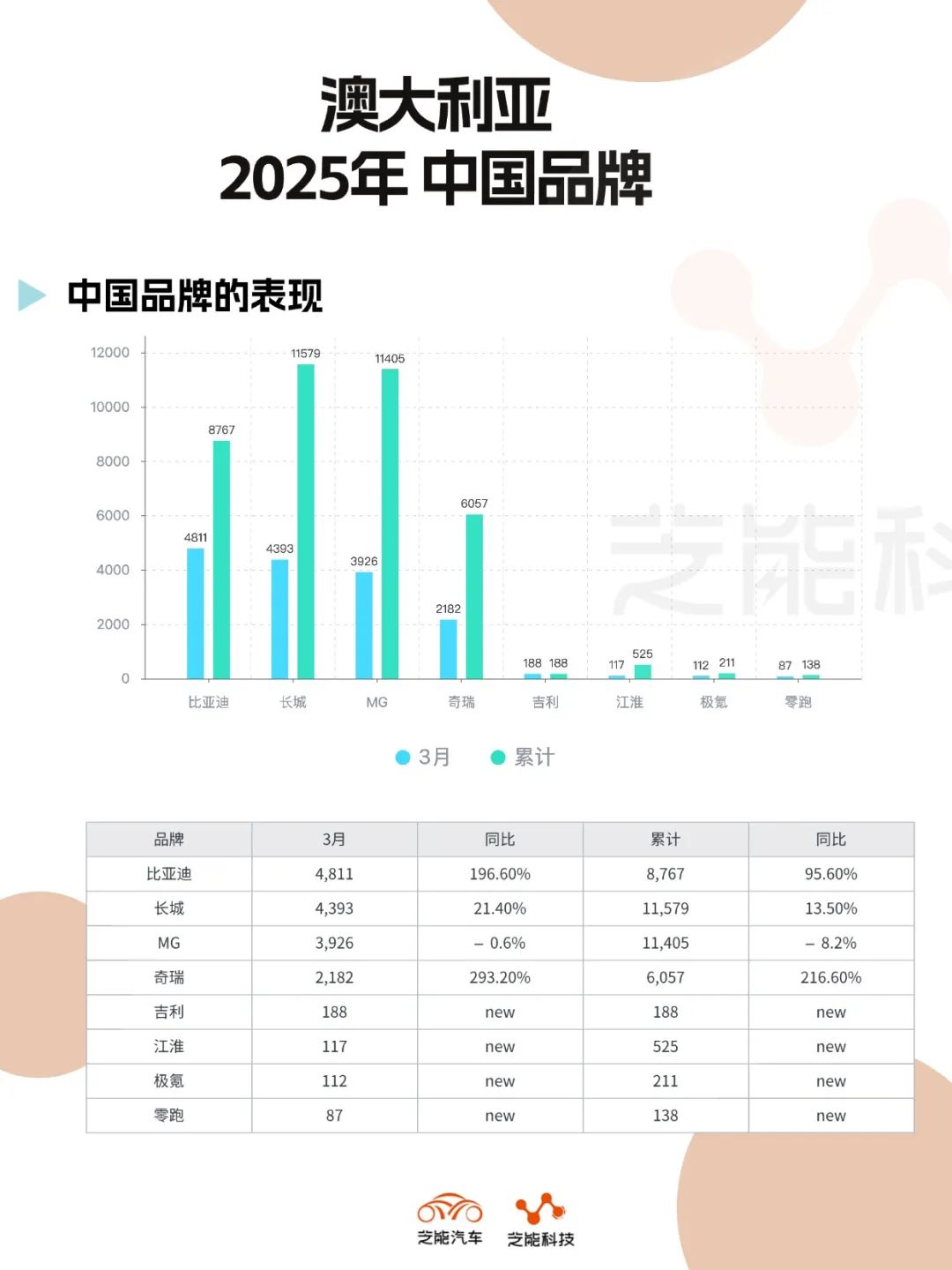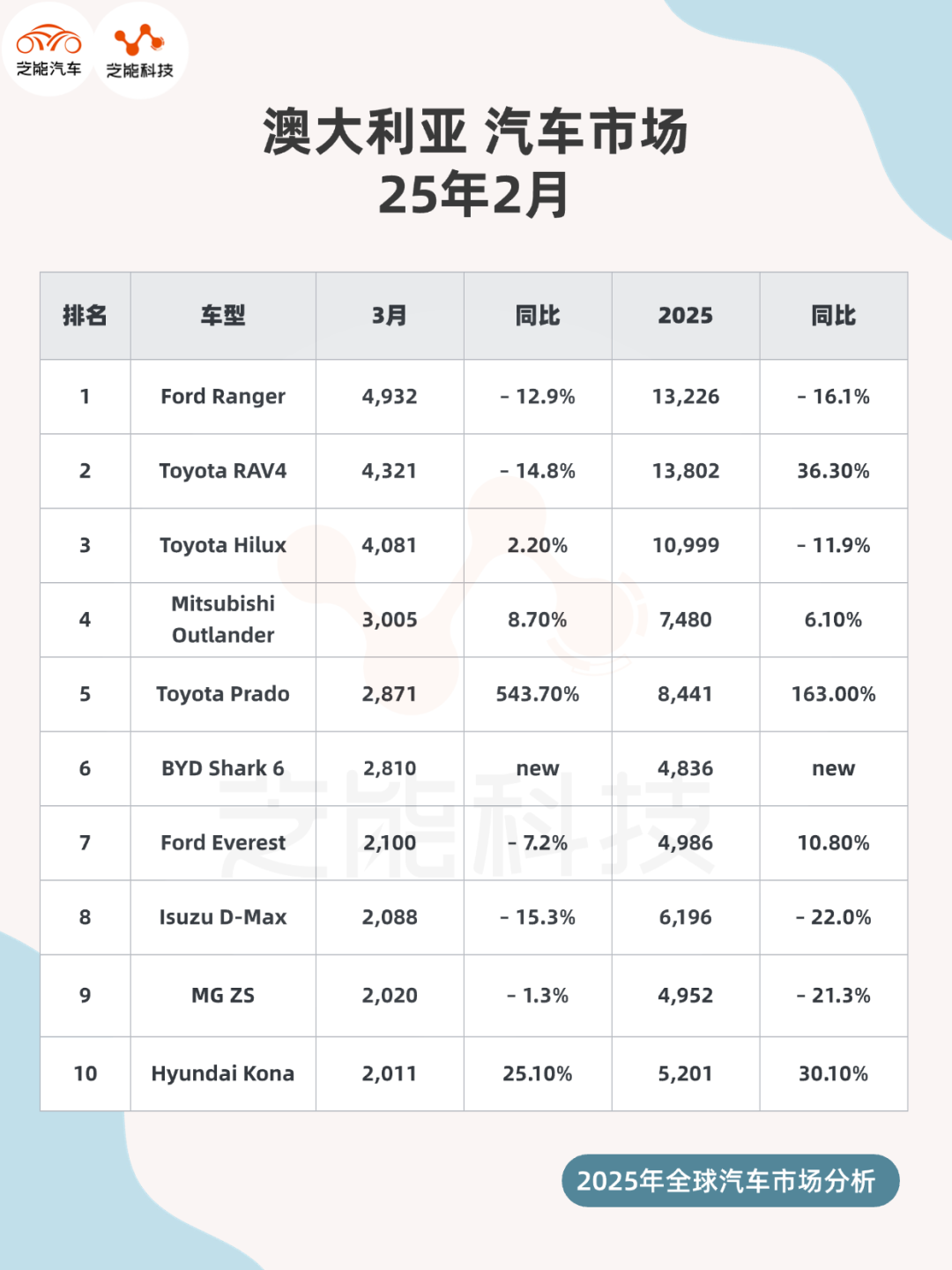March 2025 Australian New Car Market: Chinese Brands Achieve Significant Growth
![]() 04/07 2025
04/07 2025
![]() 334
334

In March 2025, Australia's new car market experienced its first positive growth of the year, with sales reaching 111,617 units, an increase of 1.8% year-on-year. However, the overall first quarter sales declined by 2.8%.
● In terms of powertrains, sales of Hybrid Electric Vehicles (HEV) and Plug-in Hybrid Electric Vehicles (PHEV) surged by 22.8% and 380.1%, respectively, while sales of Battery Electric Vehicles (BEV) fell by 19.9%, reducing their market share to 7.5%.
● In brand competition, Toyota maintained its lead, while BYD entered the top ten for the first time, recording a staggering 196.6% growth and becoming the top-selling Chinese brand.
● Among models, Ford Ranger reclaimed the top spot, and BYD Shark 6 remained in third place among pickups.
This article by ChiNeng Technology provides an in-depth analysis of the latest dynamics and future trends in Australia's automotive market, examining sales overview, brand performance, and model competition.
01
Sales Overview of Australia in March 2025: Powertrain and Brand Performance
March 2025 witnessed sales of 111,617 new cars in Australia, marking a 1.8% year-on-year increase and the first positive growth of the year, demonstrating resilience amidst economic pressures. First-quarter cumulative sales amounted to 295,952 units, down 2.8% year-on-year.
● Regionally, all states and territories except Queensland (down 4.8% to 22,417 units) reported positive growth.
- Western Australia led with a 13.6% increase (12,577 units).
- Tasmania followed with a 12.2% rise (1,806 units).
- New South Wales (34,367 units) and Victoria (30,428 units), as major markets, recorded steady growth of 1.7% and 1.1%, respectively.
● In sales channels:
- Private sales fell 2.5% to 54,806 units.
- Business fleet sales increased by 4.7% to 41,404 units, indicating commercial demand supported market growth.
● By powertrain, March data highlights market preferences and policy impacts:
- Gasoline cars: Sales declined 8.3% to 43,785 units, accounting for 39.2%, as the traditional market continues to shrink.
- Diesel cars: Sales decreased slightly by 1.2% to 31,548 units, accounting for 28.2%, and remained stable due to commercial vehicle demand.
- HEV: Sales increased by 22.8% to 16,830 units, accounting for 15.1%, indicating a preference for balanced fuel efficiency and range.
- PHEV: Sales surged 380.1% to 6,932 units, accounting for 6.2%, due to a surge in registrations ahead of the PHEV tax exemption policy expiration on March 31.
- BEV: Sales fell 19.9% to 8,385 units, with market share dropping from 9.5% last year to 7.5%, and Tesla sales plummeted by 53%.

Among new energy vehicles, the strong performance of HEVs and PHEVs contrasts sharply with the decline of BEVs, highlighting the constraints of inadequate charging facilities and high costs on the popularization of pure electric vehicles.
● In brand competition:
- Toyota retained the top spot with 20,541 units (+8.3%), capturing a 18.4% market share, though lower than the 19.5% from the beginning of the year.
- Ford ranked second with 8,232 units (-6.2%).
- Mazda and Kia took third and fourth places with 8,000 units (-3.0%) and 7,307 units (+3.4%), respectively.
- Mitsubishi and Hyundai ranked fifth and sixth with 7,265 units (-7.6%) and 6,813 units (+13.8%), respectively.
- Tesla fell to thirteenth place with 2,829 units (-53.0%), experiencing a downturn.
Chinese brands witnessed a sharp rise in the Australian market, with total sales reaching 21,358 units, up 21% year-on-year, surpassing South Korea (13,288 units, -3.4%) to become the third largest source of imports.
Key brand performances include:

- BYD: Sold 4,811 units, up 196.6% year-on-year, ranking seventh and becoming the top-selling Chinese brand in Australia for the first time, with the PHEV model Shark 6 performing prominently.
- Great Wall Motors: Sold 4,393 units, up 21.4%, ranking eighth and setting a new monthly sales record, demonstrating its strong position in the pickup truck and SUV markets.
- MG: Sold 3,926 units, down slightly by 0.6%, ranking tenth and maintaining strong competitiveness.
- Chery: Sold 2,182 units, up 293.2%, ranking seventeenth and showing rapid growth momentum, indicating expansion potential.
- Geely: Sold 188 units, ranking thirty-fifth as a new entrant, showing initial market potential.
- Other Chinese brands such as JAC (117 units) and Leap Motor (87 units) had smaller sales volumes. Chinese brands have captured a significant market share leveraging price advantages and new energy technologies.
02
Model Sales and Competitive Landscape Analysis
● The top-selling models in March are:
- Ford Ranger: Ranked first in sales (specific numbers not disclosed), down 12.9% year-on-year, reclaiming the top spot for the first time since June 2024.
- Toyota RAV4: Ranked second in sales (down 14.8% year-on-year), leading in cumulative sales for the first quarter (with a gap of only 576 units).
- Toyota Hilux: Ranked third in sales (+2.2%), maintaining a strong position in the pickup truck market.
- Mitsubishi Outlander: Ranked fourth in sales (+8.7%), achieving the best ranking since June 2024.
- Toyota Prado: Ranked fifth in sales (+543.7%), experiencing significant growth driven by new models.
- BYD Shark 6: Ranked sixth in sales, with a 2.5% market share, becoming the third best-selling pickup truck for the second consecutive month.

● From a competitive landscape perspective:
- Pickup truck market: Ford Ranger and Toyota Hilux continue to lead, but BYD Shark 6 is rapidly rising to third place with its PHEV technology. Its price competitiveness (estimated below AUD 60,000) and new energy attributes challenge the dominance of traditional diesel pickup trucks, indicating intensified competition.
- SUV market: SUVs accounted for 60.6% of sales (67,586 units, +26.3%), with Toyota RAV4 and Mitsubishi Outlander performing strongly, indicating mid-sized SUVs remain the mainstream choice. Toyota Prado's explosive growth shows the boost from new models.
- New energy vehicles: Overall BEV sales declined, while BYD Shark 6's success demonstrates PHEV potential in the Australian market. Tesla Model Y and Model 3 sales suffered setbacks (not in the top ten), reflecting a decline in price and brand appeal.
- Chinese brand competitiveness: BYD Shark 6's outstanding performance, combined with Great Wall Motors, MG, and Chery's multi-model layouts, indicates a shift from a low-price strategy to a focus on technology and market segments. New entrants like Geely will further enrich the competitive landscape.
- Traditional brands like Toyota and Ford still dominate, but Chinese brands are rapidly penetrating the market with new energy technologies and price advantages, especially in the PHEV segment, potentially becoming future disruptors.
Summary
In March 2025, amidst modest sales growth in Australia's automotive market, the rise of HEVs and PHEVs reflected consumers' demand for a balance between practicality and environmental protection. The decline in BEVs hinted at infrastructure and cost challenges. The contrast between Toyota's stable position and BYD's emergence as a dark horse is striking, with Chinese brands reshaping the competitive landscape through technological innovation and market acumen.







